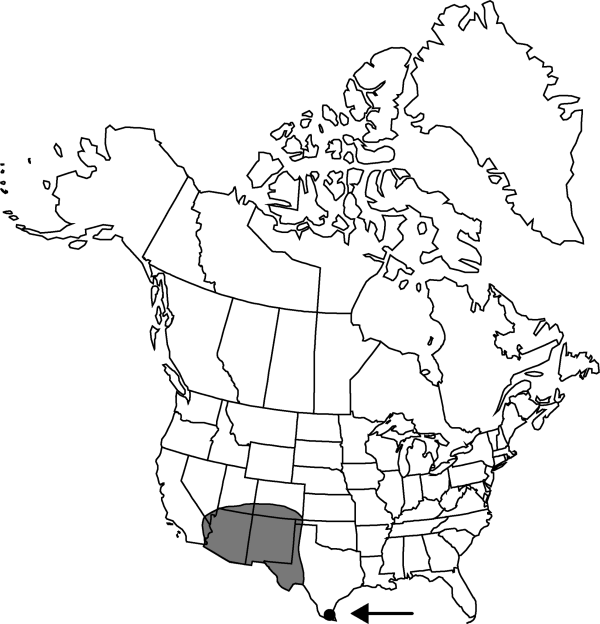Difference between revisions of "Portulaca halimoides"
Sp. Pl. ed. 2, 1: 639. 1762.
FNA>Volume Importer |
FNA>Volume Importer |
||
| Line 19: | Line 19: | ||
}}<!-- | }}<!-- | ||
| − | --><span class="statement" id="st- | + | --><span class="statement" id="st-undefined" data-properties=""><b>Plants </b>annual; roots fibrous. <b>Stems</b> prostrate to suberect, often pinkish, succulent; trichomes conspicuous at nodes and in inflorescence; branches to 3–20(–25) cm. <b>Leaf</b> blades linear to oblong-linear, terete to hemispheric, 2–14(–20) × 0.4–2(–3) mm, apex obtuse to acute; involucrelike leaves 4–8. <b>Flowers</b> 3–8 mm diam.; petals yellow, obovate, 2–4 × 1–2.5 mm; stamens 4–18; stigmas 3–4(–5). <b>Capsules</b> ovoid, 1.1–2 mm diam. <b>Seeds</b> gray or leaden, 0.3–0.5(–0.6) mm diam.; lateral surfaces with densely arranged, flattened, stellate cells, tubercles absent; usually with a smooth, occasionally papillose, spine abaxially. <b>2n</b> = 18.</span><!-- |
-->{{Treatment/Body | -->{{Treatment/Body | ||
| + | |phenology=Flowering late spring–early fall. | ||
|habitat=Dry soil, sand dunes, arroyos | |habitat=Dry soil, sand dunes, arroyos | ||
|elevation=900-2300 m | |elevation=900-2300 m | ||
| Line 41: | Line 42: | ||
|basionyms= | |basionyms= | ||
|family=Portulacaceae | |family=Portulacaceae | ||
| + | |phenology=Flowering late spring–early fall. | ||
|habitat=Dry soil, sand dunes, arroyos | |habitat=Dry soil, sand dunes, arroyos | ||
|elevation=900-2300 m | |elevation=900-2300 m | ||
| Line 48: | Line 50: | ||
|publication year=1762 | |publication year=1762 | ||
|special status= | |special status= | ||
| − | |source xml=https://jpend@bitbucket.org/aafc-mbb/fna- | + | |source xml=https://jpend@bitbucket.org/aafc-mbb/fna-data-curation.git/src/9216fc802291cd3df363fd52122300479582ede7/coarse_grained_fna_xml/V4/V4_1014.xml |
|genus=Portulaca | |genus=Portulaca | ||
|species=Portulaca halimoides | |species=Portulaca halimoides | ||
| − | |||
| − | |||
| − | |||
| − | |||
| − | |||
| − | |||
| − | |||
| − | |||
| − | |||
| − | |||
| − | |||
| − | |||
| − | |||
| − | |||
| − | |||
| − | |||
| − | |||
| − | |||
| − | |||
| − | |||
| − | |||
| − | |||
| − | |||
| − | |||
| − | |||
| − | |||
| − | |||
| − | |||
| − | |||
| − | |||
| − | |||
| − | |||
| − | |||
| − | |||
}}<!-- | }}<!-- | ||
-->[[Category:Treatment]][[Category:Portulaca]] | -->[[Category:Treatment]][[Category:Portulaca]] | ||
Revision as of 13:55, 27 July 2019
Plants annual; roots fibrous. Stems prostrate to suberect, often pinkish, succulent; trichomes conspicuous at nodes and in inflorescence; branches to 3–20(–25) cm. Leaf blades linear to oblong-linear, terete to hemispheric, 2–14(–20) × 0.4–2(–3) mm, apex obtuse to acute; involucrelike leaves 4–8. Flowers 3–8 mm diam.; petals yellow, obovate, 2–4 × 1–2.5 mm; stamens 4–18; stigmas 3–4(–5). Capsules ovoid, 1.1–2 mm diam. Seeds gray or leaden, 0.3–0.5(–0.6) mm diam.; lateral surfaces with densely arranged, flattened, stellate cells, tubercles absent; usually with a smooth, occasionally papillose, spine abaxially. 2n = 18.
Phenology: Flowering late spring–early fall.
Habitat: Dry soil, sand dunes, arroyos
Elevation: 900-2300 m
Distribution

Ariz., Calif., Colo., Nev., N.Mex., Okla., Tex., Utah, West Indies, Central America, South America.
Discussion
Young plants of Portulaca halimoides in desert areas may exhibit reddish stems and sepals. As the yellow petals fade, the persistent, reddish sepals cover the top of the capsule, giving the false impression of red flowers. Immature seeds are reddish brown to brownish black and may be papillose. Morphologic variability occurs in relation to habitat differences over the range of this species. Desert conditions produce depauperate plants; more robust specimens occur in Central America and South America. The type of P. halimoides is conspecific with P. parvula A. Gray within this context. A. Gray (1887) cited P. halimoides from the Florida Keys; that is unconfirmed and is likely a confusion with P. rubricaulis.
Selected References
None.